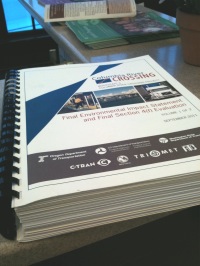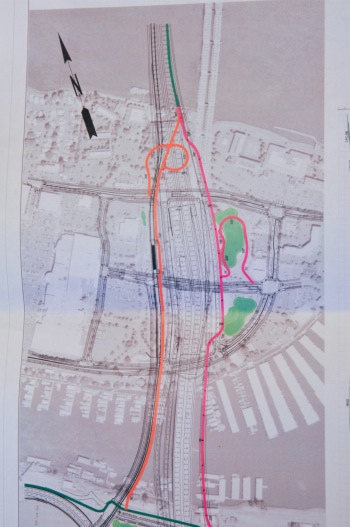
at locations throughout Portland.
(Photo © J. Maus)
It’s been several months since I last chimed in on the Columbia River Crossing (CRC) project.
Somehow, despite many lingering questions — especially around its funding plan — the $3.5 billion project which has been a roller-coaster of controversy and stops and starts over last several years — seems to have gained a bit of momentum. Or, as noted local architecture critic Brian Libby puts it, the “Frankenstein lurches closer to life.”
On September 8th, Metro council (led by ardent CRC supporter Tom Hughes) voted 5-0 in support of the CRC’s Final Environmental Impact Statement (FEIS). To give you an idea of the importance and context of that vote, here’s a snip of reporting on it from The Columbian:
“The agency is the last of the six local entities that must approve the CRC’s Final Environmental Impact Statement; the move means the document will now go to the federal government for approval.
If it passes federal muster — which planners hope will happen by December — the CRC then can begin seeking funding for its $3.1 billion to $3.5 billion bridge, highway and light rail project on Interstate 5…
Project critics had been hoping Metro’s concerns would cause them to block the FEIS from going forward.
But Metro President Tom Hughes said the CRC had addressed enough of their worries that they were comfortable giving it the go-ahead… “I think that we’re ready to go,” Hughes said. “This project has to happen…”
Down in Salem, the newly formed Legislative Oversight on Columbia River Crossing committee had its first meeting today. ODOT Director Matt Garrett and CRC project staff gave lawmakers a progress report on the project. The committee is made up of 10 state lawmakers (four in the Senate and six in the House) including Senator Ginny Burdick (D-Portland) and House Rep (and Co-Chair) Tobias Read (D-Beaverton). Many project watchers hope key questions about the project can be raised and vetted in that committee.
With its clear sense of momentum, activists who oppose the project have begun to wonder how best to move forward. At this point, there doesn’t seem to be a cohesive, coordinated effort to stop the project. Instead, there are several individuals (like economist Joe Cortright and a smattering of neighborhood activists) who continue to show up and make passionate speeches against it; but given the political muscle behind this project, it will take much more than that to stop it.
Grassroots group Stop The CRC, hasn’t been active all year. At this point, Coalition for Livable Future seems to be the main opposition.
For a project of this size, and for one that’s likely to have huge impacts on our community and our pocketbooks, the relative silence of opposition groups is quite surprising.
On the political side of things, there’s a sense that some new blood in key seats might help stymie the project (or at least improve it significantly). Bob Stacey, who narrowly lost the Metro president spot to Hughes, is running again — this time for the District 6 councilor position.
Stacey has endeared himself to anti-CRC activists for his opposition to the project and his proposed solutions.
Another political bright spot for those who want a different outcome with this project are candidates in the race to replace Portland Mayor Sam Adams.
Jefferson Smith is firmly opposed to the project. “It’s no secret that I have been a critic of the Columbia River Crossing,” Smith writes on his campaign website, “Going forward, we need projects that match our values and that we can afford.”
Joining Smith in opposition to the project is Charlie Hales, who told the Willamette Week back in June that he wouldn’t support the project in its current form.
Eileen Brady, the other mayoral front-runner, has expressed mixed feelings about the project; but hasn’t come out clearly against it yet.
As for bicycle elements of the project, the CRC’s Bicycle and Pedestrian Advisory Committee met only once in the past year. Back in July, a planner from PBOT who’s working with ODOT on the project said they’re spending about $10 million on new bikeways.
According to chapter two of the FEIS, that money will pay for:
“… new facilities such as the multi-use pathway across the Columbia River and connections to existing and future pathways, street improvements around the rebuilt interchanges, and new facilities for bicyclists and pedestrians around the new light rail stations and park and rides.”
The latest plans for bikeways on the bridge are to have a bike lane on the west side of the local bridge to Hayden Island and a 16-foot wide shared-use path on the east side.

I’ll try to delve into more bike elements of the project in the coming days.
How are you feeling about the CRC project?
— For a great roundup of news coverage over the past few months, check out this post on BlueOregon by Evan Manvel.

